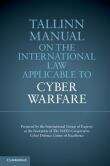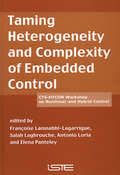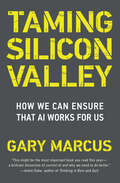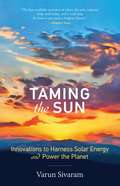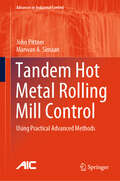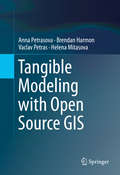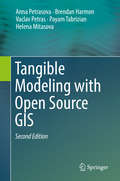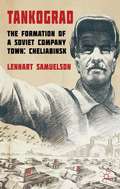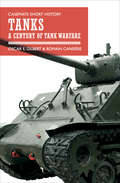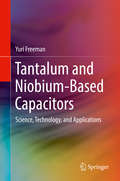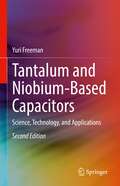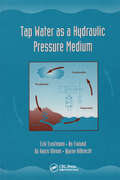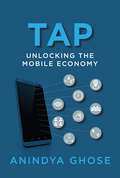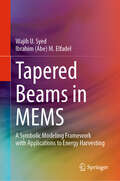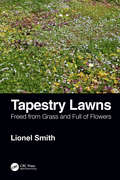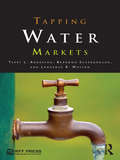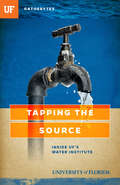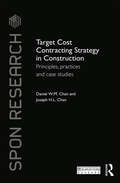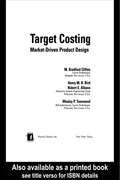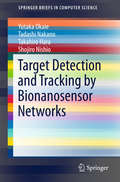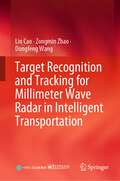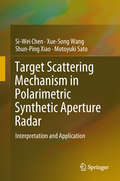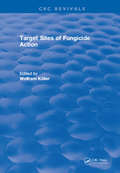- Table View
- List View
Tallinn Manual on the International Law Applicable to Cyber Warfare
by Michael N. SchmittThe product of a three-year project by twenty renowned international law scholars and practitioners, the Tallinn Manual identifies the international law applicable to cyber warfare and sets out ninety-five 'black-letter rules' governing such conflicts. It addresses topics including sovereignty, State responsibility, the jus ad bellum, international humanitarian law, and the law of neutrality. An extensive commentary accompanies each rule, which sets forth the rule's basis in treaty and customary law, explains how the group of experts interpreted applicable norms in the cyber context, and outlines any disagreements within the group as to each rule's application.
Taming Heterogeneity and Complexity of Embedded Control
by Elena Panteley Antonio Loria Salah Laghrouche Françoise Lamnabhi-LagarrigueThis book gathers together a selection of papers presented at the Joint CTS-HYCON Workshop on Nonlinear and Hybrid Control held at the Paris Sorbonne, France, 10-12 July 2006. The main objective of the Workshop was to promote the exchange of ideas and experiences and reinforce scientific contacts in the large multidisciplinary area of the control of nonlinear and hybrid systems.
Taming Silicon Valley: How We Can Ensure That AI Works for Us
by Gary F. MarcusHow Big Tech is taking advantage of us, how AI is making it worse, and how we can create a thriving, AI-positive world.On balance, will AI help humanity or harm it? AI could revolutionize science, medicine, and technology, and deliver us a world of abundance and better health. Or it could be a disaster, leading to the downfall of democracy, or even our extinction. In Taming Silicon Valley, Gary Marcus, one of the most trusted voices in AI, explains that we still have a choice. And that the decisions we make now about AI will shape our next century. In this short but powerful manifesto, Marcus explains how Big Tech is taking advantage of us, how AI could make things much worse, and, most importantly, what we can do to safeguard our democracy, our society, and our future.Marcus explains the potential—and potential risks—of AI in the clearest possible terms and how Big Tech has effectively captured policymakers. He begins by laying out what is lacking in current AI, what the greatest risks of AI are, and how Big Tech has been playing both the public and the government, before digging into why the US government has thus far been ineffective at reining in Big Tech. He then offers real tools for readers, including eight suggestions for what a coherent AI policy should look like—from data rights to layered AI oversight to meaningful tax reform—and closes with how ordinary citizens can push for what is so desperately needed.Taming Silicon Valley is both a primer on how AI has gotten to its problematic present state and a book of activism in the tradition of Abbie Hoffman&’s Steal This Book and Thomas Paine&’s Common Sense. It is a deeply important book for our perilous historical moment that every concerned citizen must read.
Taming The Sun: Innovations To Harness Solar Energy And Power The Planet
by Varun SivaramHow solar could spark a clean-energy transition through transformative innovation--creative financing, revolutionary technologies, and flexible energy systems. Solar energy, once a niche application for a limited market, has become the cheapest and fastest-growing power source on earth. What's more, its potential is nearly limitless--every hour the sun beams down more energy than the world uses in a year. But in Taming the Sun, energy expert Varun Sivaram warns that the world is not yet equipped to harness erratic sunshine to meet most of its energy needs. And if solar's current surge peters out, prospects for replacing fossil fuels and averting catastrophic climate change will dim. Innovation can brighten those prospects, Sivaram explains, drawing on firsthand experience and original research spanning science, business, and government. Financial innovation is already enticing deep-pocketed investors to fund solar projects around the world, from the sunniest deserts to the poorest villages. Technological innovation could replace today's solar panels with coatings as cheap as paint and employ artificial photosynthesis to store intermittent sunshine as convenient fuels. And systemic innovation could add flexibility to the world's power grids and other energy systems so they can dependably channel the sun's unreliable energy. Unleashing all this innovation will require visionary public policy: funding researchers developing next-generation solar technologies, refashioning energy systems and economic markets, and putting together a diverse clean energy portfolio. Although solar can't power the planet by itself, it can be the centerpiece of a global clean energy revolution. A Council on Foreign Relations Book
Tandem Cold Metal Rolling Mill Control
by Marwan A. Simaan John PittnerThis book deals with a novel and practical advanced method for control of tandem cold metal rolling processes based on the emerging state-dependent Riccati equation technique. After a short history of tandem cold rolling, various types of cold rolling processes are described. A basic mathematical model of the process is discussed, and the diverse conventional control methods are compared. A detailed treatment of the theoretical and practical aspects of the state-dependent algebraic Riccati equation technique is given, with specific details of the new procedure described and results of simulations performed to verify the control model and overall system performance with the new controller coupled to the process model included. These results and data derived from actual operating mills are compared showing the improvements in performance using the new method. Material is included which shows how the new technique can be extended to the control of a broad range of large-scale complex nonlinear processes.
Tandem Hot Metal Rolling Mill Control: Using Practical Advanced Methods (Advances in Industrial Control)
by Marwan A. Simaan John PittnerTandem Hot Metal Rolling Mill Control is a response to the significant control engineering challenges posed by the nature and circumstances of the hot metal strip rolling process. The process is large, complex, multivariable and nonlinear with significant disturbances and subject to multiple situationally dependent time delays all of which are exacerbated by the demands of an ever-more-competitive marketing environment for its product. The book provides innovative solutions not available with previously existing methods of control. It introduces new advanced control methods, including a nonlinear control method based on an advanced state-dependent Riccati equation technique coupled with virtual rolling to improve performance during various regimes of mill operation. The book begins with a brief history of metal rolling and an overview of the tandem hot metal rolling process. It then discusses process models, including physical-system and state-space equations, and control methods currently being used in tandem rolling. The exposition of the new advanced control method uses figures and simulations to facilitate thorough understanding of the methods and their applicability in the real world. The final chapter concludes with a brief discussion of variable-speed drives as typically used in modern installations. Although sufficient mathematical treatment is provided to support the development of novel concepts, the presentation is not highly mathematical, making the text readily understandable and useful to a variety of readers in both academic and practical engineering milieux.
Tangible Modeling with Open Source GIS
by Helena Mitasova Anna Petrasova Brendan Harmon Vaclav PetrasThis book presents a new type of modeling environment where users interact with geospatial simulations using 3D physical models of studied landscapes. Multiple users can alter the physical model by hand during scanning, thereby providing input for simulation of geophysical processes in this setting. The authors have developed innovative techniques and software that couple this hardware with open source GRASS GIS, making the system instantly applicable to a wide range of modeling and design problems. Since no other literature on this topic is available, this Book fills a gap for this new technology that continues to grow. Tangible Modeling with Open Source GIS will appeal to advanced-level students studying geospatial science, computer science and earth science such as landscape architecture and natural resources. It will also benefit researchers and professionals working in geospatial modeling applications, computer graphics, hazard risk management, hydrology, solar energy, coastal and fluvial flooding, fire spread, landscape, park design and computer games.
Tangible Modeling with Open Source GIS
by Helena Mitasova Anna Petrasova Brendan Harmon Vaclav Petras Payam TabrizianThis book provides an overview of the latest developments in the fast growing field of tangible user interfaces. It presents a new type of modeling environment where the users interact with geospatial data and simulations using 3D physical landscape model coupled with 3D rendering engine. Multiple users can modify the physical model, while it is being scanned, providing input for geospatial analysis and simulations. The results are then visualized by projecting images or animations back on the physical model while photorealistic renderings of human views are displayed on a computer screen or in a virtual reality headset. New techniques and software which couple the hardware set-up with open source GRASS GIS and Blender rendering engine, make the system instantly applicable to a wide range of applications in geoscience education, landscape design, computer games, stakeholder engagement, and many others. This second edition introduces a new more powerful version of the tangible modeling environment with multiple types of interaction, including polymeric sand molding, placement of markers, and delineation of areas using colored felt patches. Chapters on coupling tangible interaction with 3D rendering engine and immersive virtual environment, and a case study integrating the tools presented throughout this book, demonstrate the second generation of the system - Immersive Tangible Landscape - that enhances the modeling and design process through interactive rendering of modeled landscape. This book explains main components of Immersive Tangible Landscape System, and provides the basic workflows for running the applications. The fundamentals of the system are followed by series of example applications in geomorphometry, hydrology, coastal and fluvial flooding, fire spread, landscape and park design, solar energy, trail planning, and others. Graduate and undergraduate students and educators in geospatial science, earth science, landscape architecture, computer graphics and games, natural resources and many others disciplines, will find this book useful as a reference or secondary textbook. Researchers who want to build and further develop the system will most likely be the core audience, but also anybody interested in geospatial modeling applications (hazard risk management, hydrology, solar energy, coastal and fluvial flooding, fire spread, landscape and park design) will want to purchase this book.
Tank Cascade Systems of Sri Lanka: A Globally Important Agricultural Heritage System
by Nalaka Geekiyanage Manjula Ranagalage Gunarathna, M.H.J.P.The Tank Cascade System (TCS) of Sri Lanka is a connected series of tanks organized within a micro-catchment of a dry zone landscape for storing, conveying, and utilizing water from a temporary stream. FAO and the UN internationally recognize it as a Globally Important Agricultural Heritage System for food security and sustainable development in a changing climate. This edited volume offers comprehensive and holistic coverage of the entire scope of cascade systems including their origins, governance, and integration with agriculture, biodiversity, cultural linkages, associated livelihoods, degradation causes, restoration efforts, gender perspectives, and disaster resilience.Features: Provides comprehensive coverage of the evolution of the Tank Cascade Systems over two millennia in Sri Lanka. Offers a holistic understanding of multifaceted dimensions of TCS from ecological importance to economic potential and offers a well-defined roadmap towards securing sustainable TCS. Addresses critical challenges of water quality, deterioration and prevalence of human health issues, human-wildlife conflicts, and land degradation. Discusses perspectives of restoring significant agricultural heritage systems around the globe for solving environmental and agricultural problems. Includes practical case studies with replicable models for integrated landscape management and livelihood enhancement. Outlines strategic approaches to sustainable management, encompassing ecosystem restoration, resilience against disasters, and gender-inclusive strategies. This book is for researchers, academics, graduate, and senior undergraduate students in agriculture, environmental science, ecology, and soil science, and those interested in water conservation and sustainability in tropical landscapes. It also serves as an insightful reference for industry and government professionals, and human rights activists.
Tankograd
by Lennart SamuelsonA major production site of Soviet KV and T-34 tanks in WWII, the town of Cheliabinsk in the Urals was nicknamed 'Tankograd', its civilian machine-building factories swiftly converted to arms production. This book gives a social, economic and political panorama that describes everyday life in a typical Soviet company town during the Stalin era.
Tanks: A Century of Tank Warfare (Casemate Short History)
by Oscar E. Gilbert Romain V. Cansière&“For all the history buffs on warfare of the last century, Tanks is a perfect choice . . . packed with fascinating information&” (San Francisco Book Review). This Casemate Short History—by the authors of Tanks in Hell: A Marine Corps Tank Company on Tarawa—provides an informative and entertaining introduction to this iconic weapon of the last hundred years. Tanks first ventured into battle on the Somme in 1916, and by the end of the war, countries were beginning to choose &“heavy&” or &“light&” tank designs to suit their preferred doctrine. Design then stagnated until World War II brought about rapid change. Tanks would prove integral to fighting in almost every theater; the Germans swept across Europe using tanks to spearhead their blitzkrieg method of war, until Soviet tanks proved more than their match and led to some epic tank battles on a huge scale. After World War II, tank designs became increasingly sophisticated and armor undertook a variety of roles in conflicts, with mixed results. American armor in Korea was soon forced into an infantry support role, which it reprised in Vietnam, while Soviet armor was defeated in guerrilla warfare in Afghanistan. However, tanks played a pivotal role in the American &“shock and awe&” doctrine in two wars in Iraq, and tanks remain a crucial weapons system on the battlefield. &“Comprehensive despite its conciseness. For example, it addresses the employment of tanks in lesser-known conflicts such as the Indio-Pakistani and Sino-Vietnamese wars. The book provides context for contemporary tank operations and offers a perspective on the way ahead.&” —Military Review
Tantalum and Niobium-Based Capacitors
by Yuri FreemanThis book provides a comprehensive analysis of the science, technology, and applications of Tantalum and Niobium-based capacitors. The author discusses fundamentals, focusing on thermodynamic stability, major degradation processes and conduction mechanisms in the basic structure of Me-Me2O5-cathode (Me: Ta, Nb). Technology-related coverage includes chapters technology chapters on the major manufacturing steps from capacitor grade powder to the testing of finished capacitors. Applications discussed include high reliability, high charge and energy efficiency, high working voltages, high temperatures, etc. The links between the scientific foundation, breakthrough technologies and outstanding performance and reliability of the capacitors are demonstrated. The theoretical models discussed include the thermodynamics of the amorphous dielectrics, conduction mechanisms in metal-insulator-semiconductor (MIS) structures, band diagrams of the organic semiconductors, etc.
Tantalum and Niobium-Based Capacitors: Science, Technology, and Applications
by Yuri FreemanThis book provides a comprehensive analysis of the science, technology, and applications of Tantalum and Niobium-based capacitors. The author discusses fundamentals, focusing on thermodynamic stability, major degradation processes and conduction mechanisms in the basic structure of Me-Me2O5-cathode (Me: Ta, Nb). Technology-related coverage includes chapters on the major manufacturing steps from capacitor grade powder to the testing of finished capacitors. Applications include high reliability, high charge and energy efficiency, high working voltages, high temperatures, etc. The links between the scientific foundation, breakthrough technologies and outstanding performance and reliability of the capacitors are demonstrated. The theoretical models discussed include the thermodynamics of the amorphous dielectrics, conduction mechanisms in metal-insulator-semiconductor (MIS) structures, band diagrams of the organic semiconductors, etc.Since the publication of the 1st edition, principally important new results on the impact of technology on the reliability, failure mode, volumetric efficiency, and environmental stability of Solid Electrolytic and Polymer Tantalum capacitors, which dominate the market, were obtained. Based on these results, new possibilities for the reliable mission critical applications of the surface mount tantalum capacitors manufactured with advanced technologies were demonstrated. These new results added to the 2nd edition not only significantly expand the scope of the book, but also provide important corrections and clarity to the earlier published material.
Tap Water as a Hydraulic Pressure Medium
by Erik Trostmann"Showcases the beneftis and potential advantages of water hydraulics over oil-based media. Interweaves examples and excercises throughout the text to illustrate critical concepts, with helpful appendices on abbreviations, symbols, conversion factors, and water contaminants, and glossary sections."
Tap: Unlocking the Mobile Economy
by Anindya GhoseHow the smartphone can become a personal concierge (not a stalker) in the mobile marketing revolution of smarter companies, value-seeking consumers, and curated offers. Consumers create a data trail by tapping their phones; businesses can tap into this trail to harness the power of the more than three trillion dollar mobile economy. According to Anindya Ghose, a global authority on the mobile economy, this two-way exchange can benefit both customers and businesses. In Tap, Ghose welcomes us to the mobile economy of smartphones, smarter companies, and value-seeking consumers. Drawing on his extensive research in the United States, Europe, and Asia, and on a variety of real-world examples from companies including Alibaba, China Mobile, Coke, Facebook, SK Telecom, Telefónica, and Travelocity, Ghose describes some intriguingly contradictory consumer behavior: people seek spontaneity, but they are predictable; they find advertising annoying, but they fear missing out; they value their privacy, but they increasingly use personal data as currency. When mobile advertising is done well, Ghose argues, the smartphone plays the role of a personal concierge—a butler, not a stalker.Ghose identifies nine forces that shape consumer behavior, including time, crowdedness, trajectory, and weather, and he examines these how these forces operate, separately and in combination. With Tap, he highlights the true influence mobile wields over shoppers, the behavioral and economic motivations behind that influence, and the lucrative opportunities it represents. In a world of artificial intelligence, augmented and virtual reality, wearable technologies, smart homes, and the Internet of Things, the future of the mobile economy seems limitless.
Tapered Beams in MEMS: A Symbolic Modeling Framework with Applications to Energy Harvesting
by Ibrahim (Abe) Elfadel Wajih U. SyedThis book addresses important aspects of MEMS designs that are well established in engineering practice but rarely discussed in the standard textbooks. One such aspect is the ubiquitous use of tapered beams in the sensing and actuation elements of MEMS designs. As explained in this book, the tapered beam has distinct advantages over the standard rectangular beam but these advantages are often left unarticulated due to the blind trust in the finite-element models of MEMS devices. In this monograph, the authors take a fundamental, physics-based approach to the modeling of tapered beams in MEMS that is based on a rigorous perturbation analysis of the traditional Euler-Bernoulli beam. The authors demonstrate how perturbation methods combined with symbolic modeling and the tools of computer algebra enable the development of semi-analytical models for tapered-beam MEMS elements. They pay particular attention to the application of these novel models to piezoelectric MEMS energy harvesters with tapered-beam elements, including the development of lumped-parameter circuit models that can be readily used for fast electro-mechanical simulations. Another important aspect of MEMS designs that is extensively addressed in the book is the uncertainty quantification (UQ) of tapered-beam MEMS elements using both Monte Carlo and polynomial chaos expansion methods. These UQ methods are applied to the design of variation-aware piezoelectric energy harvesters. With consistent focus on MEMS devices with tapered beam elements, this up-to-date monograph
Tapestry Lawns: Freed from Grass and Full of Flowers
by Lionel SmithSwathes of the human world are covered in ornamental grass lawns; they are the single most commonly encountered horticultural feature on the planet. Unfortunately, they are now often viewed as resource-draining green deserts due to the lack of plant and animal diversity, the need for frequent mowing and watering, and addition of lawn greening products to keep them looking at their best. It is a venerable horticultural feature that is essentially frozen in time, and with few alternatives to whet the appetite, the lawn has languished in its current grass-only format for decades. Until now. Tapestry lawns are a new, practically researched and timely development of the ornamental lawn format that integrates both horticultural practice and ecological science and re-determines the potential of a lawn. Mown barely a handful of times a year and with no need for fertilisers or scarifying, tapestry lawns are substantially richer in their diversity of plant and animal life compared to traditional grass-only lawns and see the return of flowers and colour to a format from which they are usually purposefully excluded. Tapestry Lawns: Freed from Grass and Full of Flowers traces the changes in the lawn format from its origins to the modern day and offers information on how and why the tapestry lawn construct is now achievable. It provides guidance on how to create and maintain a tapestry lawn of your own and champions the potential benefits for wildlife that can follow. Features Accessible and informative to all types of readers from academic to amateur Includes a refined and tested set of useful tapestry lawn plants Contains step-by-step instructions for creation and management methods of grass-free lawns Illustrated in full colour If you have ever thought about mowing your lawn much less, making it much more colourful and wildlife friendly, then this book will inform and guide you to create a perfect, grass-free lawn.
Tapping Water Markets
by Terry L. Anderson Brandon Scarborough Lawrence R. WatsonTapping Water Markets is about the past, present, and future of water markets. It compares water markets with political water allocation, documents the growth of water markets, and explores the ways in which water markets can be improved and implemented further. This book provides up-to-date information of where and why water shortages are occurring and where and why water markets are evolving to resolve conflicting water uses. Though the main focus is on the United States, it includes examples from other parts of the world to show how water markets are beginning to thrive. It contains institutional detail that is accessible to people who are not economic or hydrologic experts, and comes alive with numerous examples and case studies of water markets. The book begins with an analysis of water institutions as they have varied over time and location. It then covers a range of discrete water management topics including surface water allocation, groundwater management, environmental flows, and water quality trading. The book concludes with predictions about the future of water scarcity and the ability of water markets to shape that future more positively.
Tapping the Source: Inside UF's Water Institute
by University of Florida Terry TomalinThe University of Florida has an ambitious goal: to harness the power of its faculty, staff, students, and alumni to solve some of society’s most pressing problems and to become a resource for the state of Florida, the nation, and the world. Florida has 51,858 miles of rivers and streams, more than 2 million acres of lakes and ponds, 11.4 million acres of wetlands, 4,437 square miles of bays and estuaries, and 8,436 miles of coastline. But these water resources face myriad threats. Tapping the Source takes us inside the UF Water Institute, where talent from throughout the university address complex water issues through innovative research, education, and public outreach programs. Interdisciplinary teams from the School of Natural Resources and Environment, the School of Forest Resources and Conservation, Environmental Engineering Sciences, Geological Sciences, Soil and Water Science, and other departments develop new scientific breakthroughs, creative engineering, policy and legal solutions, and pioneering educational programs that are renowned for addressing state, national, and global water-resource problems. The teams work to manage nitrate flows into the north-central Florida springs, evaluating whether reduction of these nitrates alone will be enough to return the springs to their natural state. They assess the impact of pollutants and other stressors on the aquifer and look at historic rainfall averages and the abundance of algae and grazers, like freshwater snails, present in the ecosystem. Ultimately, they attempt to balance the demand for drinking water for a growing population and irrigation water for agriculture with the simultaneous pressures to prevent pollution and leave enough water for natural ecosystem functions. The stories chronicled in Gatorbytes span all colleges and units across the UF campus. They detail the far-reaching impact of UF's research, technologies, and innovations--and the UF faculty members dedicated to them. Gatorbytes describe how UF is continuing to build on its strengths and extend the reach of its efforts so that it can help even more people in even more places.
Target Cost Contracting Strategy in Construction: Principles, Practices and Case Studies (Spon Research)
by Daniel W.M. Chan Joseph H.L. ChanThe problems inherent in the traditional design-bid-build procurement method often lead to the adversarial working relationships within the construction industry. Target cost contracts, accompanied by a gain-share/pain-share arrangement serving as a cost incentive mechanism, have emerged in the United States, the United Kingdom, Australia and Hong Kong with the aim of achieving better value for money and more satisfactory overall project performance under a collaborative working relationship. This book presents the underlying principles, practicalities and a series of short case studies of applying the target cost contracting strategy. Principles begin with the fundamentals then cover the development of target cost contracting in major countries/cities, definitions of target cost contracting, perceived benefits, potential difficulties and critical success factors for implementation. Practices include the target cost contracting approach and process in general, the key risk factors, risk assessment model, risk allocation and risk mitigation measures for target cost contracts in particular, together with a conceptual framework for the performance measurement of target cost contracts. Several short real-life case studies from the United Kingdom, Hong Kong, Australia and New Zealand are provided for further illustration. The book will appeal to a wide spectrum of readers from industrial practitioners to undergraduate students, researchers and academics interested in construction contracts and procurement methods.
Target Costing: Market Driven Product Design (Mechanical Engineering)
by M. Bradford Clifton Wesley P. Townsend Henry M.B. Bird Robert E. AlbanoCompiling practical recommendations gleaned from more than 20 years of professional experience, Target Costing: Market Driven Product Design provides numerous examples from field authorities that illustrate valuable concepts and approaches employed in the application of target costing to large-scale manufacturing operations. The authors discuss set
Target Detection and Tracking by Bionanosensor Networks
by Tadashi Nakano Takahiro Hara Yutaka Okaie Shojiro NishioThis book describes the main ideas, methods, results and resources relevant to the study of bionanosensor networks. Its primary goal is to spark application-oriented studies of molecular communication; that is, to investigate how collections of bionanosensors, referred to here as bionanosensor networks, can be used for practical purposes such as nanomedical sensing. In particular, the book focuses on two key functionalities for nanomedical applications: target detection and target tracking. Bionanosensor networks represent a new interdisciplinary research area that expands the traditional area of network engineering by incorporating the latest advances in bionanotechnology. These networks consist of spatially distributed bionanosensors that are engineered with the help of bionanotechnology. As a research area, bionanosensor networks are aimed at designing robust networks on the basis of spatially distributed bionanosensors, as well as at developing innovative applications of those networks.
Target Recognition and Tracking for Millimeter Wave Radar in Intelligent Transportation
by Lin Cao Zongmin Zhao Dongfeng WangThis book starts with the introduction of the radar working system from a mathematical point of view. It shows the composition of transmitted signal and echo signal, and describes the principle of speed measurement and distance measurement for different radar systems. The book focuses on millimeter-wave radar technologies related to echo signal denoising, target identification, clustering, and target tracking and develops a workable plan for the information fusion idea between millimeter-wave radar and machine vision.This book breaks down the systematic processing flow of millimeter-wave radar echo signals one by one from the standpoint of intelligent transportation, concentrating on the introduction of principles and reinforced by a plethora of experimental instances. So that readers from all relevant professions may comprehend millimeter-wave radar's involvement throughout the complete system process.
Target Scattering Mechanism in Polarimetric Synthetic Aperture Radar: Interpretation And Application
by Si-Wei Chen Xue-Song Wang Shun-Ping Xiao Motoyuki SatoThis book presents new and advanced concepts, theories and methodologies in polarimetric synthetic aperture radar (PolSAR) target scattering mechanism modeling and interpretation, which is dedicated to bridge the gap between the acquired data and practical applications. It proposes adaptive and generalized polarimetric target decompositions, to precisely interpret the target scattering mechanisms. Further, it develops a uniform polarimetric matrix rotation theory and a polarimetric coherence pattern visualization and interpretation tool to completely explore and characterize the deep information and target signatures in the rotation domain. Finally, it demonstrates land cover classification, target detection, natural disaster damage investigation and mapping applications which use the novel scattering mechanism investigation tools.The book is a valuable resource for senior undergraduate and postgraduate students, teachers, engineers and researchers in the field of microwave remote sensing, radar polarimetry, imaging radar, and environmental studies.
Target Sites of Fungicide Action
by Wolfram KoellerTarget Sites of Fungicide Action presents a critical examination of the mode of action of antifungal inhibitors, especially the mechanistical aspects of agricultural fungicides and antifungal drugs. It provides an interdisciplinary approach through its discussions of inhibitors with target sites in sterol biosynthesis, molecular studies in fungicide research, and fungal resistance. Researchers and students in plant pathology, mycology, and medicine will find this book to be a comprehensive summary of current knowledge, as well as a source of stimulation for future research in the field of applied mycology.
